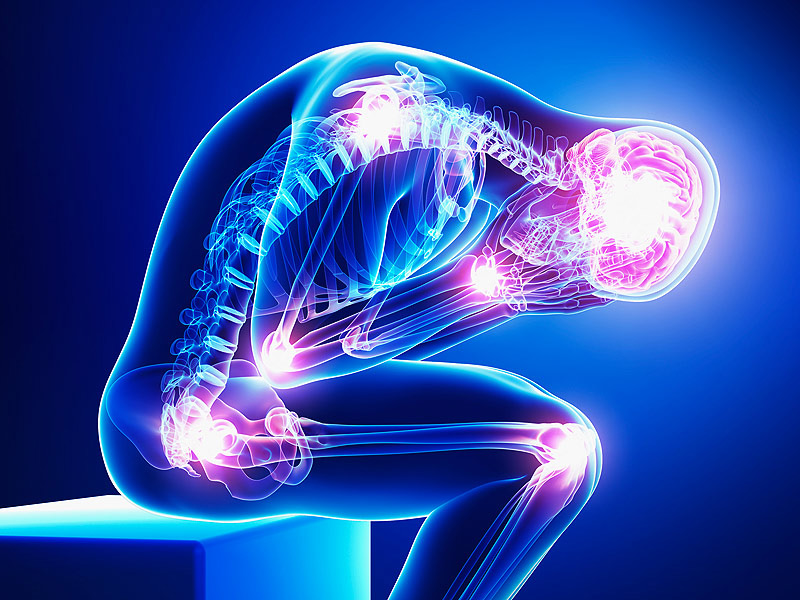Whether you have a chronic illness like fibromyalgia or rheumatoid arthritis or you have suffered an injury, Chronic Pain is a common ailment felt by a lot of people. Chronic Pain can lead to changes in lifestyle and emotions and ability to do activities you once enjoyed. It can also make relationships harder because of the changes in mood that happen when you are hurting all the time. Chronic Pain is a pain that lasts longer than six months and affects how you live your daily life. Chronic Pain is both physically and emotionally stressful since constant pain can lead to anger and frustration.
Chronic Pain is often treated with:
- Over the counter or prescription medications
- Physical therapy
- Surgery
- Pain management strategies
The first thing you should do when you are dealing with Chronic Pain is find out as much as you can about the condition that is causing your pain. Ask questions of your doctor about treatments and activities that might reduce your pain. Request referrals to physical therapists and other specialists if your doctor thinks it would benefit you. Read about your condition and look for support groups. Support groups can be a way to focus on the positive and be supportive of others as well as build a feeling of community. Remain proactive about your body and your wellness.
When dealing with Chronic Pain it is very important to manage your stress levels.
- Eat well; Certain foods and drinking alcohol and coffee can increase inflammation which increases pain. Eating plenty of vegetables and proper amounts of fruits and lean meats can fuel your wellness for optimum success.
- Get enough sleep; Your body heals while you sleep both in your body and your mind so make sure to make sleep a priority.
- Proper exercise; Endorphins that are released during exercise improve your mood and reduce pain sensations. Exercise also helps keep your weight down and reduces the risk for high blood pressure, heart disease and high blood sugar. However some movements can make pain worse for some people so it is important to learn what you can do and you can’t.
- Stop smoking; smoking increases your risk of heart disease and cancer and also can cause painful circulation problems.
In addition to these, there are many ways to help you deal with the stress felt when you live with Chronic Pain. If you need help with a diet plan and how to get started on a workout regime consider hiring a Wellness Advocate like Karen G Clemenson at Wellness Works NW. Also talking constructively to yourself is really important. Focus on what you can do instead of what you can’t. Find a hobby that makes you feel good and helps you connect to family, friends or people in your community and help you avoid depression that comes with feeling isolated.
Chronic Pain is not just a sensation that we feel but an indicator of how our brain processes pain signals. Pain signals can invoke all kinds of feelings. People who enjoy sports, may see pain as something to overlook so they can keep going, while others may feel anxiety or fear.
The International Association for the Study of Pain has stated: pain is always subjective and is defined by the person who experiences it.
Managing the sensation of pain using mind control and coping strategies can help people who live with Chronic Pain feel more empowered and less dependent on pain medications.
It is important to have proper medical evaluations of your pain before you begin any new regiment. Some types of pain require surgery or other forms of treatment. Once you know what type of pain you have, there are several pain management strategies that may be very affective at helping you manage your pain.
- Biofeedback involves a special machine, used by a professional, to help you learn to control bodily functions. Biofeedback can help you learn how to release muscle tension and also to reinforce relaxation training. When you have mastered the technique the machine will not be needed and you can use this tool any time you need to.
- Dissociation is a mental process that creates distance or a feeling of detachment from Chronic Pain.
- Distraction is purposely moving your attention to something else other than pain. Some forms of Distraction could be looking at pictures that invoke happy feelings, or any activity that you enjoy doing. Other forms of Distraction techniques that are helpful in changing your focus to a more positive one and to more positive mental thoughts are watching a favorite movie, reading a good book, listening to music, talking to a friend and using positive self-talk.
- Hypnosis can be used to change your perception of Chronic Pain. During Hypnosis a therapist will give you a post-hypnotic suggestion that reduces the level of pain felt. Some people choose to learn self-hypnosis as a form of relaxation training that allows people to hypnotize themselves when the pain is so severe it stops them from functioning.
- Progressive Muscle Relaxation focuses on slowly tensing and then relaxing each muscle group. This process helps you learn the difference between tension and relaxation and helps you become more aware of physical sensations. One method of Progressive Muscle Relaxation starts at your toes and works your way toward the neck and head. Tense your muscles for at least 5 seconds and then relax for 30 seconds and then repeat.
- Relaxation Training involves concentration and slow, deep breathing techniques that release tension from muscles and help relieve Chronic Pain. Many people listen to CDs or DVDs to help teach these techniques. You must practice these techniques in order do them well.
- Visual Imagery involves using visualization or concentration on sound or pictures, words or thoughts to create a pleasant and relaxing moment. Sometimes tapes are used to help teach these skills.
Many researchers suggest Yoga or Tai Chi for building strength and helping to maintain pain levels. As someone who has hurt herself by trying a pose without instruction, I would highly recommend that you talk to Alicia at Holos Yoga and Wellness for personal help. She offers classes at all levels and she would love to meet you. You can call her at 360-261-8596.
You are not alone. Anyone can be subject to Chronic Pain. Just like you, your action plan to deal with your pain is different than other people. Here are a few celebrities that are still moving forward, while they manage their Chronic Pain:
- George Clooney is a famous actor and activist. In 2005 he suffered a serious back injury while filming Syriana. He has had a number of surgeries to correct the damage to the dura that wraps around the spine and holds in spinal fluid. Before these surgeries, his pain was so terrible he even considered suicide as an option. He still lives with chronic pain and has had to turn down high-action acting roles because of it.
- Jennifer Gray was in a car accident in 1987 that has left her with chronic neck pain. Because of this pain, while undergoing a surgery to insert a plate in her neck to ease pain and prevent further damage, her doctors found a cancerous tumor on her thyroid that had not had time spread and they were able to remove it without an issue. While on Dancing with the Stars in 2010 she ruptured a disc in her lower back. She has had surgery to repair the disc and lives with little pain. Her doctor has encouraged her to keep moving.
- Cynthia McFadden was diagnosed with Crohn’s disease in 1977, well before she became ABC News/Nightline anchor. She has learned that humor and other coping mechanisms have really helped her live with the intestinal pain that comes with her disease, that she refers to as “George.”
- Jillian Michaels is known as a trainer on, “The Biggest Loser,” but she also lives with endometriosis and Polycystic Ovary Syndrome (PCOS). She has suffered with debilitating abdominal pain and found some alleviation of symptoms by following an organic diet and regular exercise.
- Sinead O’Connor is a rock star who lives with Fibromyalgia and bipolar disorder. “Fibromyalgia is not curable. But it’s manageable. You get to know your patterns and limits, so you can work and plan around it,” said the mother of four.
- Kathleen Turner is an actor who has lived with a diagnosis of rheumatoid arthritis since 1992. For a while she relied on alcohol to get her through the pain, but after she made the choice to become sober, she was able to get on a path to find the medication that helped her go into remission. She says that early treatment is key to managing rheumatoid arthritis.
- Montel Williams has lived with pain since he was a teenager. In 1999 he was finally diagnosed with multiple sclerosis. He chose to share with the public in order to create an urgency to find a cure and now heads the Montel Williams Foundation, that raises funds for a cure for MS. He has also written several books, including Body Change, which shares the exercise regime he uses to stay strong and keep symptoms at bay.
Chronic Pain can cause both emotional and physical pain; it can steal your life as you know it but you don’t have let it take you over. Learn your limits and what works for your body. Explain your needs to your loved ones so they can be supportive and keep looking for new things to learn and do to build yourself up. Focus on your family, friends, work, hobbies and your community. Chronic Pain may change your life, but you can still have a productive and happy life. It’s all up to you.
Read more at:
- American Chronic Pain Association
- American Psychological Association: Coping with Chronic Pain
- Everyday Health: Coping With Chronic Pain
- Mayo Clinic: Types of relaxation techniques
- Prevention: 7 Celebrities Who Manage Life With Chronic Pain
- Spine-health: Chronic Pain Coping Techniques – Pain Management
- WebMD: 11 Tips for Living With Chronic Pain
 Summer D Clemenson co-owns Clemenson Enterprises and Wellness Works NW with her wife, Karen G Clemenson. Their personal motto is Creativity, Honesty & Positivity are a must! This mantra helps them stay community and wellness minded in all they do. Summer also writes poetry and inspirational blogs @ ClemensonEnterprises.com. Her crochet art can be viewed and purchased @ KnottyWares.com & she loves special orders!
Summer D Clemenson co-owns Clemenson Enterprises and Wellness Works NW with her wife, Karen G Clemenson. Their personal motto is Creativity, Honesty & Positivity are a must! This mantra helps them stay community and wellness minded in all they do. Summer also writes poetry and inspirational blogs @ ClemensonEnterprises.com. Her crochet art can be viewed and purchased @ KnottyWares.com & she loves special orders!













